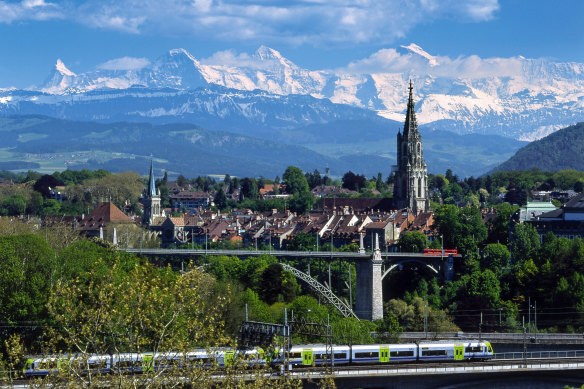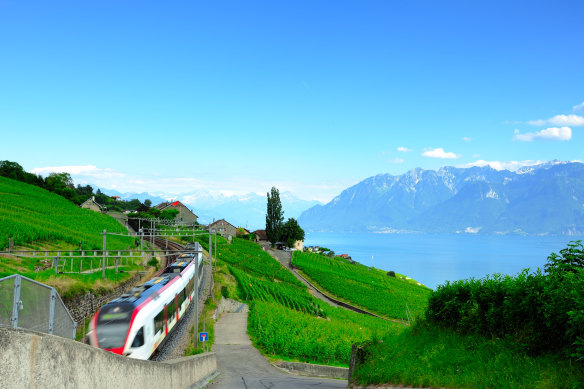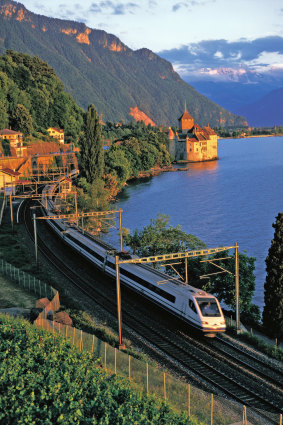Even the commuter trains are spectacular in this country
Want to know why you should take a train in Switzerland? I’m not talking about those expensive private trains to mountain summits. I’m talking ordinary trains. The trains that Swiss commuters get every day, the trains weekend hikers take, and Zurich bankers going home to see their grannies in alpine valleys.

The Swiss Alps and the old town of Bern. Taking it all in from the train.
Hop on a train that runs along the north shore of Lake Neuchatel and you’ll know why. Or the north shore of Lake Geneva. Actually, any shore of any Swiss lake. Or through a valley. Or over a pass. Or whatever, just get on a train. It hardly matters which one.
Look out the window and you’ll see why. Mountains and lakes. Old towns with pie-crust roofs and pepper-pot towers. Vineyards strung like sheet music across undulating hills. Larch forests aflame in autumn colour. I spent the first half of my life in Switzerland and have ridden its rails for decades, but have yet to find ugly or uninteresting scenery.
Train rides are among the top things I miss about my former life. We Australians aren’t conditioned to thinking of trains as the pleasant transport option. Australia is too big and flat and its trains too sluggish and temperamental.
In Switzerland, a train ride isn’t a chore but a worthy experience. Modern Switzerland was built around trains. City stations are right within a squint of battlements, main shopping streets and hotels. And Swiss cities are small. Ride a train out of town and you only endure graffitied inner-city concrete for minutes.

Take a commuter train along the banks of Lake Geneva.Credit: iStock
All Swiss trains guarantee the same thing. You’ll slide out of the station as the red second hand on the iconic Swiss railway clocks lurches to the vertical. You’ll have a comfortable seat and clean window. A neatly uniformed and polyglot ticket inspector will come wandering along.
Blue station signs flash by, announcing unheard-of towns that sound like science-fiction planets: Aargau, Rothrist, Dottikon, Root. If you alight, pointy yellow signs indicating walking and cycling paths soon have you in forests and fields.
On a train, you can go where your whim takes you. You can hurtle on an express train through the St Gotthard Tunnel and, leaving a foggy autumn day behind, burst out into sunlit, Italian-speaking Ticino and have lunch under palm trees.
Trains will take you just about anywhere: to Zurich Hauptbahnhof, one of Europe’s busiest train interchanges, or to stops that barely have a platform. St-Saphorin is tiddly but sandwiched between steep vineyards and Lake Geneva. At Lungern in central Switzerland you practically step from the carriage into flowery fields amid an undulating cow-chewed landscape.

Alongside Lake Geneva.
If trains can’t get there, connecting postal buses will. These jaunty yellow buses will take you to any of 14,600 rural or alpine bus stops. Get on the bus to Griesalp at Reichenbach train station and you climb into the high Alps in minutes. A bus from Martigny corkscrews over Forclaz Pass. You can even get into Swiss National Park on a postal bus.
Another good reason to hit the rails instead of the roads is that you do your bit for sustainability. Rail accounts for 16 per cent of passenger travel in Switzerland but only consumes 5 percent of transport energy, almost all of it from hydroelectricity. The journey between Bern and Zurich uses 23.6kg of carbon dioxide by rental car, but only 0.8kg by train.
But why would you want to drive anyway? You’re on the wrong side of the road, you have to concentrate, you can’t twist your neck for another look at a passing sight. And there are plenty of sights by the tracks.
Trains whizz right past castles and geranium-splattered chalets, right past the Coppet chateau where Madame de Staël lived in well-upholstered literary exile, and right through fields were munching cows get busy creating the milk used to make Gruyere. Brilliant.
THE DETAILS
FLY
Swiss flies daily with codeshare partners from Sydney and Melbourne to Zurich via Singapore or Hong Kong. See swiss.com
TOUR
Swiss Travel Pass offers unlimited travel on trains, lake steamers, postal coaches, urban public transport and some mountain trains, plus admission to more than 500 museums. See swisstravelsystem.com
The writer was a guest of Switzerland Tourism (myswitzerland.com) and Swiss Travel System.
Sign up for the Traveller Deals newsletter
Get exclusive travel deals delivered straight to your inbox. Sign up now.